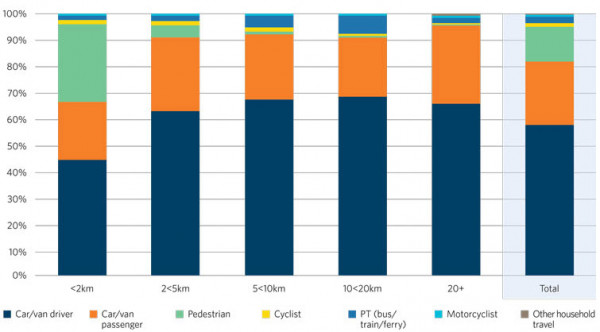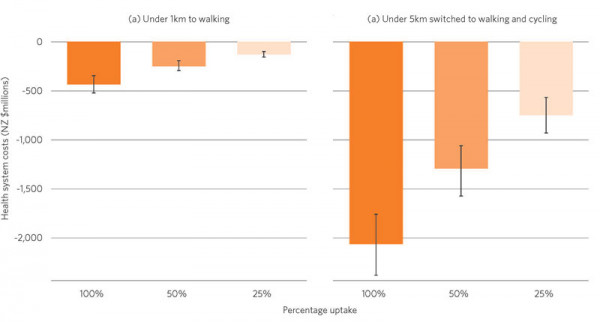The New Zealand Household Travel Survey (HHTS) shows that of the estimated 6000 million plus trips made by New Zealand households annually, nearly one in five (17 percent) was made by walking.[1] New Zealanders spend 205 million hours annually as pedestrians in the road environment and walk an estimated 807 million kilometres per year.
Research into household travel undertaken for the New Zealand travel survey identifies every leg of a journey as a ‘trip’. For example, a trip to the bus stop, followed by a bus ride, followed by a walk at the other end would count as two walking trips and a public transport trip. Similarly, a motor vehicle trip to work, with a stop on the way at a dairy, would count as two motor vehicle trips to two separate destinations. By focusing on ‘trips’, we can better see the multi-modal nature of many of our journeys, enabling us to plan better for all the modes of transport involved. A walking trip is defined as being at least 100 m in length or crossing a road.
Around 84% of walking trips involve getting from A to B solely on foot. Around 16% were undertaken in association with other modes of transport (eg walking from a parked car or walking to and from public transport).
A recent study into Understanding attitudes and perceptions of cycling & walking (Waka Kotahi, 2021)[2] found that:
Walking for transport includes walking for any non-recreational purpose, such as to or from schools, shops, work, visiting friends or family, or to public transport stops/stations. Although walking for transport is a broad definition it can be helpful particularly when planning and designing for walking to replace or support other modes of transport and therefore can have a greater impact on mode shift.
The HHTS 2015-2017 found that on the average day, 81% of New Zealand adults reported no walking for transport.[3]
Between the late 80’s and 2014, the average daily time spent walking dropped from 10 minutes to 8 minutes while the length of time spent driving has increased slightly (see image below).[4] Over the same time period, car-dominated urban sprawl[5] and resulting increasing trip distances (estimated at 1% increase per year)[6] has made walking a less practical mode for many people.

Change in time spent driving and walking since the late 1980s. (Source: Ministry of Transport, 2014)
Although there has been a decline in walking for transport, New Zealanders’ love walking for leisure. Walking is New Zealanders’ preferred recreation activity with 64% of adults walking regularly.[7] This suggests that improving the attractiveness of the walking environment could increase the amount that people walk for transport.
As shown below ninety percent of walking trips are less than 2km long[8]. For trips of 2km or less, the walk mode share is 30%. Only 4% of trips longer than 2km are made on foot. The implication is that towns and cities designed to have shorter trip distances will have more walking.

Mode distribution of trip legs by distance of trip leg, main urban areas. (Source: HHTS 2015-2017 data)
Twelve per cent of all car trips in New Zealand are under 1km; if all these short car journeys were made on foot instead (scenario 'a' in graph below), it is estimated that would lead to a 3% mode shift overall. That translates to 23,900 quality adjusted life years (QALYs) and nearly half a billion dollars in healthcare costs saved over the lifespan of the current adult population.[9]

New Zealand healthcare savings from mode shift. (Source: Mizdrak et al 2019)
People tend not to walk for trips that take more than 30 minutes, and walk more when trip durations are short.
In New Zealand’s main urban areas, 99% of walking for transport trips are less than 5km, and 90-91% are less than 2km [10].
Walking to school is also declining:
Some of the key barriers to active school travel include personal security (‘stranger danger’) and traffic safety concerns.[13] [14].
[1] Ministry of Transport. (2015). Walking: New Zealand Household Travel Survey 2011–2014
[2] Waka Kotahi NZ Transport Agency. (February 2021). Understanding attitudes and perceptions of cycling and walking [PDF, 5.9 MB]
[3] Ministry of Transport. (2017). New Zealand Household Travel Survey 2015–2017
[4] Ministry of Transport. (2015). Household Travel Survey, 25 years of New Zealand Household Travel 1989–2014(external link)
[5] Chaston, D. (2018). Visualisations showing how seven of our cities have grown over time(external link)
[6] Sullivan, C. & O'Fallon, C. (2010). Kilometres travelled and vehicle occupancy in urban areas: improving evaluation and monitoring(external link). Waka Kotahi NZ Transport Agency Research Report 399
[7] Sport NZ. (2018). Active NZ Survey(external link). Accessed 20 January 2020(external link)
[8] Ministry of Transport. (2018). New Zealand Household Travel Survey 2015–2018(external link)
[9] Mizdrak. A, Blakely. T, Cleghorn, C.L. & Cobiac, L.J. (2019) Potential of active transport to improve health, reduce healthcare costs, and reduce greenhouse gas emissions: A modelling study(external link) PLoS ONE 14(7): e0219316
[10] Waka Kotahi NZ Transport Agency. (2022). Sustainable urban mobility benchmarking [PDF, 3.4 MB]
[11] Ministry of Transport. (2015). Walking: New Zealand Household Travel Survey 2011–2014(external link)
[12] Ministry of Transport. 25 years of New Zealand Household Travel 1989–2014(external link)
[13] Cheyne, C., Imran, M. (2017). Barriers to Active Transport in Palmerston North: Experiences and Perspectives of Secondary School Students(external link)
[14] Boshier, P. (2017). Ombudsman investigation into the Ministry of Education’s engagement processes for school closures and mergers(external link)